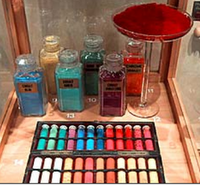 To launch the "2-minute Design History" series (see previous post) we start, where it often begins: with colors. You may be familiar with the physics of optics, the cultural connotations of color, the psychology of color, or maybe even the varied spellings of the word colour, but what very few of us ever stop to ponder is the material itself. The pigments, the paint, the oils, the ink, the raw materials - all of which we almost completely neglect in today's digital world but, surprisingly, once you take the lid off this rainbow colored can of worms, you discover a well of inspiration, delight and relevance that runs centuries deep, and it's downright fun.
To launch the "2-minute Design History" series (see previous post) we start, where it often begins: with colors. You may be familiar with the physics of optics, the cultural connotations of color, the psychology of color, or maybe even the varied spellings of the word colour, but what very few of us ever stop to ponder is the material itself. The pigments, the paint, the oils, the ink, the raw materials - all of which we almost completely neglect in today's digital world but, surprisingly, once you take the lid off this rainbow colored can of worms, you discover a well of inspiration, delight and relevance that runs centuries deep, and it's downright fun.Even as digital designers, we sometimes start with a sketch, a scanned photograph, some ink on a napkin - but colour is usually a Photoshop or Pantone palette of mathematic evenness, precision and reliability. When we look back at an old Flemish Master work or a Sistine chapel, we have almost no way of realizing how damn near impossible it was to achieve the shadow, saturation, luminescence, and realism.
Not only did they not have a pre-made palette of millions of colours to choose from with a click of an eye dropper, but Mr. da Vinci, for example, had to sit down and "cook" from scratch every red, blue and yellow, along with varnish and glue to hold the paint in place...and only then, after weeks or maybe months of preparation (of burning sienna or grounding stones) could he begin to put brush to cloth for his Mona Lisa. Save that thought for a moment when a program is taking forever to load.
In her book Colour - Travels Through the Paintbox, (also known as Color - The Natural History of the Palette) Victoria Finlay travels the historical and geographical world of color, artists and pigments to get to the bottom of the dangerous ochres that are power, magic and land for indigenous artists, the mango oranges made of cow pee, the bright purples made of snail tears, the enticing hues extracted from dead bodies, the poisonous reds, illegal greens and the way materials, their makers and their users have literally shaped the history of art and design from 30,000 years ago.
The artist's "craft" used to be so secret only apprentices, after years of lackey labour for their masters, could begin to know it. This book is full of secrets, and it's as exciting as a treasure hunt to find out that the greatest fakers used day-old egg to age canvas or that artists cooked yellow to make red. You'll also find that the knowledge of color, materials and pigment is actually quite relevant to us right now.
After all, if the medium is the message, there's a whole lot of message in this book. You may find the techniques and secrets inspire you to try something more organic to launch your next design - to get down in the dirt and start your digital opus with something back to the roots. A unique texture, an irresistible uneveness, an unpredictable gradation. One thing's for sure, it will be one of a kind.
You'll find the knowledge you pick up in this colour adventure is not only good for pub conversation, it's also good professionally. So pick it up and get to know your world of colours.
Where to find
Colour by Victoria Finlay
